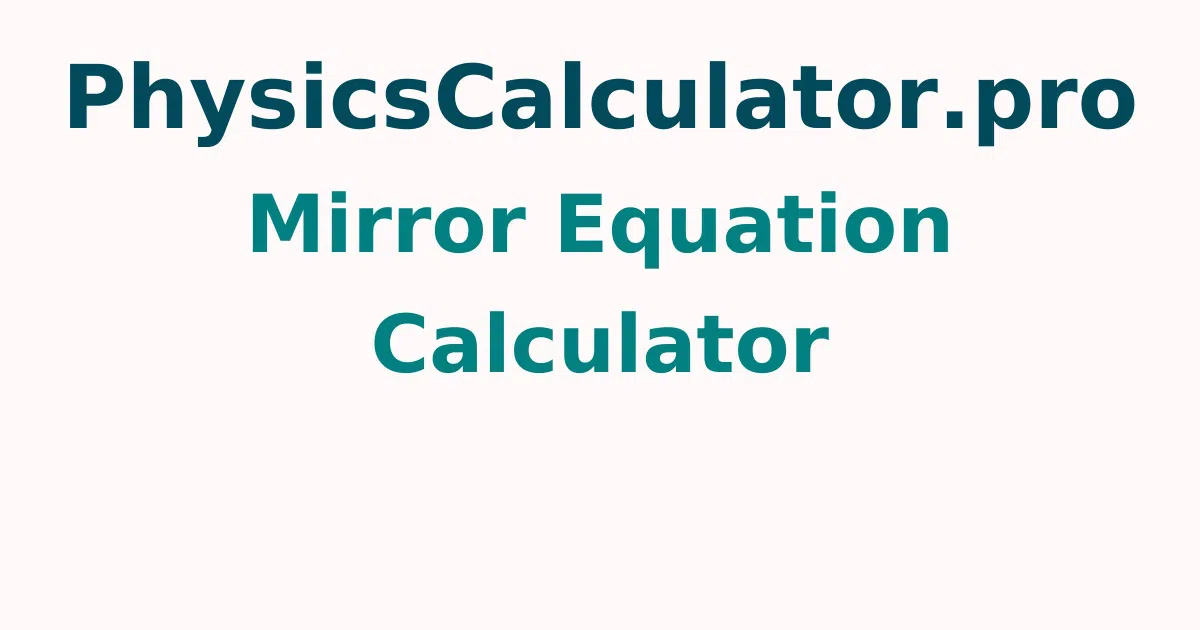Mirror Equation Calculator
The unknown variable among the object and image distances from the pole of a mirror, its focal length, and radius curvature can be easily determined using our mirror equation calculator. This tool also aids in the identification of the two forms of mirror magnification – linear and areal – as well as the avoidance of common errors made when using the Cartesian sign convention for mirrors.
For Curved Mirrors, what is the Mirror Formula?
The mirror formula ties the object and image distances from a mirror's pole to the focal length of the mirror. The equation that connects these three variables is as follows: 1/f = 1/ u + 1/v
- Where ff - Mirror focal length: the distance between the primary focus and the pole of the mirror.
- vv - Image distance: the distance between the created image and the mirror's pole.
- uu - Object distance: the distance between the put object and the mirror's pole.
Plane mirrors can also be calculated using the mirror formula. The focal length of a plane mirror, ff, is infinite. As a result, the mirror formula is:
1/ ∞ = 1/ u + 1/v OR, u = -v
In terms of the radius of curvature, how do I write the Mirror Equation?
The radius of curvature of a mirror is equal to the radius of the sphere in which it is embedded. A mirror's focal length, f, is always half of its curvature radius, r: f = r/2
As a result, the mirror equation can be written as follows:2/r = 1/ u + 1/v
How do I use the Mirror Equation?
- Step 1: Determine the distance between the object and the mirror.
- Step 2: Calculate the picture of the thing that the mirror projects from the mirror itself.
- Step 3: Using the equation above, calculate the radius of curvature and focal length.
Get acquainted with different types of physics concepts along with their calculators to make your calculations quick and simple on Physicscalculatorpro.com a trusted portal for all your needs.
Why is a Plane Mirror's Focus Length Infinity?
A plane mirror's reflected rays do not diverge from a point or converge onto a point. They are always in line with each other. As a result, we regard the focal length of a plane mirror to be infinite.
A plane mirror is considered to be a component of a sphere with an infinite radius. As a result, it is a spherical mirror with an unlimited curvature radius and an infinite focal length.
FAQs on Mirror Equation Calculator
1. What are the drawbacks of using the mirror formula?
The curved surfaces will be planes if the radius of curvature R is sufficiently great in comparison to u and v. As a result if R is arbitrarily large, 2/R equals zero. As a result, if an object is placed in front of a mirror, the image will appear behind it. However, because the formula is so simple, it isn't used.
2. Is there a mirror formula for flat mirrors?
No, the mirror formula holds true for both flat and spherical mirrors in all object positions.
3. Is there a difference between the formula for a mirror and a lens?
Even though a lens is a transparent medium, distances can only be measured in one direction when using it. However, because a mirror is a reflecting surface, the rays are redirected back to the source. As a result, in a mirror formula against a lens formula, a significant difference is required.
4. When applying the mirror formula, what is the focal length of a flat mirror?
The image can be generated at an endless distance inside the mirror, the focal length of a flat mirror is limitless. A spherical mirror with an infinite radius of curvature is referred to as a plane mirror. The focal length is infinite since it is half the radius of curvature.
5. How can you tell if a mirror is real or fake?
When light rays really cross at the image, it creates a true image that is inverted, or upside down. When light beams do not truly intersect at the image, it is called a virtual image. Instead, your eye "sees" the image because light rays are reflected backward. The right half of a virtual image is up (upright).
